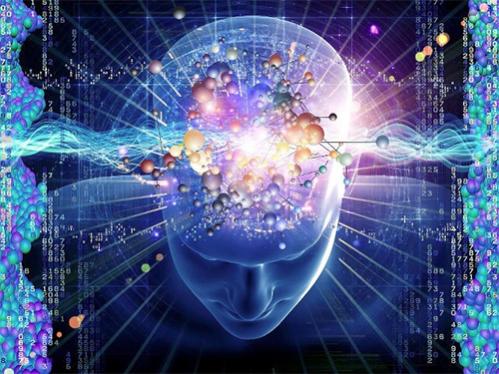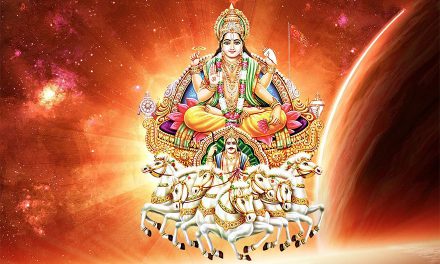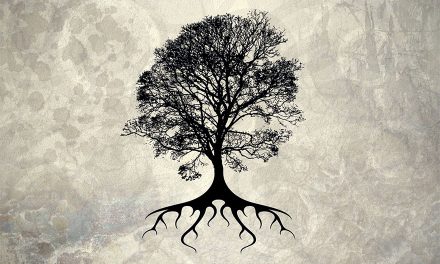
This world is sometimes pushing forth and sometimes withdrawing. In the same way that a heart expands and contracts again and again, the whole universe expands and contracts. Regrouping within the one, and again manifest as the many – the one and the many – the evolution and dissolution of the material universe takes place. As a heart expands and contracts, the whole universe is manifest and withdrawn.
One ancient literature of India, the Manu Samhita, begins by describing the creation. In that book, it is written how, before the creative movement began, the tatastha potency of the Lord was in eqilibrium. Tatastha means equilibrium. Everything was in darkness, fully enveloped by ignorance. There was no possiblility of estimation; no symptoms of reality existed by which any conjecture or inference about the nature of reality would have been possible. And that state of being was unknowable: science has no capacity for investigating the nature of that stage of existence. We can only say from here that it was completely immersed in deep sleep. The analogy of deep sleep may give us some conception of that period: Material existence was at that time as if in sound sleep.
At that time, movement began from within the spiritual plane, and light came. Light was seen by the suddenly awakened seers, the sages present at the moment of creation. That light was pre-existent, but at that moment the awakened seers received the vision to see light. They began to see. The first conception of this material world after light was water. The light revealed a moving substance like water seen by the sages.
That primal light is compared with personality. That light, or personality, first gave birth to onlookers – to the feelers of material existence – and then to an objective substance like water. The conscious world is represented by light and the first objective reality is represented by water. Then the seeds of consciousness are sown in the causal water which is the shadow of that light. Although the actual element of water was created long after this, the first conception of matter is compared to water because water is an accommodating, moving solution. The Sanskrit word for water – apa – means “of lower conception.” In this way, the lower creation began.
Then, in connection with the seeds of consciousness and primal water, the next production was known as mahat-tattva: the energy of consciousness represented by light, mixed with matter as a mass. When the mass of matter is infused with the energy of light-consciousness, that is known as mahat-tattva.
After further development, that entity was divided into many units of ego. First there is a mass ego as a whole. The element of conglomerate ego is called mahat-tattva; and from that conglomerate a watery objective substance evolves – by the influence of consciousness. That objective substance expresses itself in five main ways: as substance that can be seen, smelled, tasted and touched and heard. These fivefold elementary substances are the primitive principles of material existence, known as fire, earth, water, air and sky (ether, space).
The Awakening of The Awareness “I AM”
In a primitive state when the individual egos are massed together as a common whole, that conglomerate false ego, the primitive sense of awarenes that “I am”, develops from a state of equilibrium. It evolves, it differentiates into innumerable individual units of localised awareness. Just as an atom can be broken down into subatomic particles, electrons, protons, neutrons and so on, the conglomerate ego gradually breaks into its component individual egos: jiva souls. Their position is tatastha; marginal and undetectable. From that subtle, undetectable plane of marginal energy, consciousness first develops into the detectable plane as a whole, and then innnumerable individual spiritual units are manifest from that lump of ego, or mahat-tattva. Gradually, the other elements of creation develop within this negative plane of exploitation – negative, because here every living being feeds on the bodies of others.
Consciousness is producing everything. Consciousness is eternal; this world is not eternal. So many times the sun, the Earth, and the solar systems disappear, and again spring up. We are in the midst of such thought in eternity. The sun, the moon, and all the planets appear and vanish: they all die and then again they are created. We are told by the sages who spoke the literature of the Veda to view things from this viewpoint: not only this living body I have, but the human race, the animals, the trees, the entire Earth, and even the sun, will all vanish, and again spring up. Creation, dissolution, creation, dissolution – it will continue forever in the domain of misconception. At the same time, there is another world which is eternal – the land of Sri Krishna. We are requested to enter there, to make our homes in that plane which neither enters into the jaws of death, nor suffers any change.
In Vrindavana, the land of Sri Krishna, everything is conscious, though some things are posing in a passive way. But they are all conscious: the Yamuna river, the cows, the trees, the fruit – everything is conscious, spiritual; but they pose in different ways. Being able to contact the conscious characteristic in everything, the Aryans saw all of nature as conscious and personal, and addressed everything as conscious beings.
The Aryans, the spiritually developed persons of former times, used to see everything as consciousness. Everything is a person. The great rishis, whose thinking is highly developed, address whatever they find within the environment as if they were all persons. In the Vedas, the ancient scriptural inheritance of India, we find that the sages are always in the midst of so many persons in their natural surroundings; in the background everything we experience is a person. It is all personal. And so the rishis with such a vision of reality used to address everything as a person: the trees, the mountains, the sun, the moon, the ocean. They are conscious persons in some mixed stages of consciousness; a person suffering karma. “Person” means not a fully developed spiritual person at present, but a person in a mixed, worldly condition.
The Awakening of Brahma, The Imagineer Of The Universe
The first position of a soul in the material world will be like that of Brahma, the creator. Then his karma may take him to the body of a beast like a tiger, where he is surrounded by a tigerish mentality, or to the body of a tree or creeper, where different impressions may surround him. In this way, one becomes involved in action and reaction. The case is complex; to analyze the details of the history of a particular atom is unnecessary. We are concerned with the general thing: how the transformation of the material conception springs from pure consciousness.
Everything is conscious. As the present scientists say everything is matter, we have real cause to think that everything is consciousness.
Matter does not evolve into a human form and brain and then produce the idea of “soul;” rather the soul contains within it, in one negligible portion, the conception of matter. Like an eczema, it is a disease. The concept of a “material world” exists like an eczema in a wholesome body.
This is the understanding given by the Veda, the literature of ancient India. It would certainly be a wonderful miracle if stone could produce the soul, but it is easier and more reasonable for us to think that the soul has produced the conception of stone. In the soul, there are many conceptions, and one conception is that of stone.
The conscious world is very near and the material world is very far off. Try to conceive of reality along these lines: Soul, Spirit, Consciousness, is nearer to you and you are a child of that soil. Matter is far, far away from you. But when we go to observe “objective reality” the interrupting planes of shadowy mundane consciousness are so close together that we don’t see the nature of the spiritual reality, just as when you put your hand over your eye, you can’t see your hand. But if the hand is one foot away, we can see it very clearly.
Although the Buddhists and atheists argue that consciousness is a material thing, I say that there is no material thing. If I am to answer the question of whether or not consciousness is produced from matter, then I shall say that nothing is material. Whatever I feel, it is only a part of consciousness. Everything is an idea. We are connected only with consciousness from the beginning to the end of our experience. Beyond consciousness, we cannot go. Everything is an idea: the stone, the tree, the house, the body – all are ideas. The plane of consciousness is very much closer to us than we perceive. We are involved only with ideas. Everything within our experience is only part of our mind.
The Ideal World
Everything in Vrindavana, the land of Krishna, is Krishna conscious. Every tree, creeper and shrub. Their consciousness may be understood in this way: if a man meditating does not move about and harm anybody, that does not mean he is paralyzed; he is simply in a passive mood. So also in Vrindavana, service may be rendered to the Lord in a passive mood. The Yamuna river is absorbed in rendering service in a passive mood. Then there is also Govardhan hill in Vrindavana. That is also a kind of pose. How this is so can be understood by the analogy of a drama. In a drama in the theatre, an actor may play the part of a dead man. As his body is being carried, he can’t say anything, he can’t move – but that does not mean he is dead. Similarly, a meditative devotee may assume a passive role as a creeper, a shrub, or a tree in Vrindavana, in order to enhance the drama of Sri Krishna’s daily pastimes.
Here in this material world a particle of sand is nothing; it is ignored. But there, everything is well-attended. In Vrindavana there is no ignorance. No interest of anything is ignored there; everything is harmonised within the Divine Pastimes of Sri Krishna, and therefore the conception of Vrindavana in Krishna consciousness is the highest concept of full-fledged theism. The ancient literature Srimad Bhagavatam says: “Whenever Krishna sets His feet like lotus petals on the ground within Vrindavana, the Earth Goddess personified says, “My fate is fulfilled, I have achieved my highest fortune.” For in Vrindavana the earth, the very dust, feels the pleasure of the highest type of conjugal love merely by the touch of His lotus feet. Wherever Krishna puts His footsteps, the Earth’s joy knows no bounds. By His touch, the Earth feels the most intense type of ecstacy.













